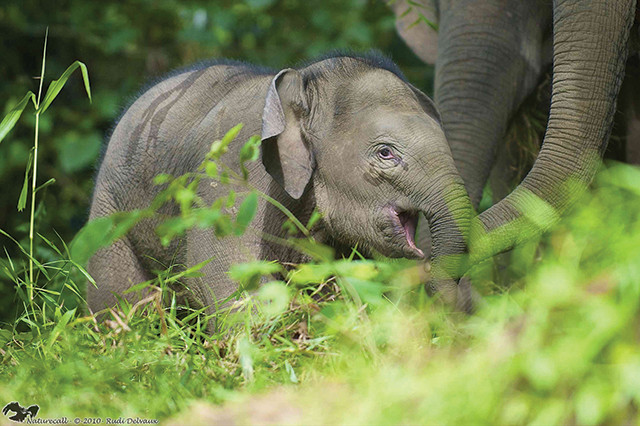
by Mary Caperton Morton Tuesday, April 10, 2018

The Bornean elephant is the smallest subspecies of elephant. This baby is one of fewer than 2,000 individuals that remain in the wild. Credit: Rudi Delvaux.
Elephants may not seem like islanders, but a small population lives on the Southeast Asian island of Borneo. How and when the animals arrived on the island has long been a mystery. A new DNA analysis points to colonization at the end of the Pleistocene, when a land bridge may have connected Java, Borneo and Sumatra to the Malay Peninsula and mainland Asia.
Theories about when and how Borneo’s elephants arrived have typically fallen into one of two categories: that humans introduced nonnative elephants several centuries ago, or that elephants colonized Borneo hundreds of thousands of years ago. Historical records show that, in the 17th century, the Bornean Sultan was offered a gift of now-extinct Javan elephants from the Sultan of the Sulu Islands in the Philippines. Meanwhile, no elephant fossils have been found on Borneo to support a much earlier colonization, although previous mitochondrial DNA studies suggested the Bornean elephant has been separated from its Asian ancestors for at least 300,000 years.
In the new study, led by Reeta Sharma of the Gulbenkian Institute of Science in Portugal and Benoît Goossens of Cardiff University in England, researchers analyzed samples from 35 Bornean elephants for genetic markers that might provide clues about the population’s origins. Mitochondrial DNA, along with computational modeling, pointed to a third story: that the elephants are neither recent additions to the island nor ancient denizens, the team wrote in Scientific Reports.
“Our results suggest that the most likely scenario to have occurred is a natural colonization of Borneo around 11,400 to 18,300 years ago,” Sharma said in a statement. “This period corresponds to a time when the sea levels were very low and elephants could migrate between the Sunda Islands, a Southeastern Asia archipelago to which Borneo belongs. We cannot exclude more complex scenarios, but a historical human introduction seems very improbable, and so does a very ancient arrival.”
© 2008-2021. All rights reserved. Any copying, redistribution or retransmission of any of the contents of this service without the expressed written permission of the American Geosciences Institute is expressly prohibited. Click here for all copyright requests.